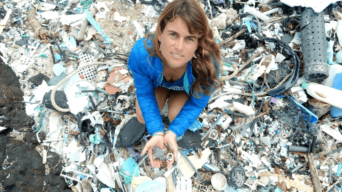Climate : how marine plastic waste contributes to global warming
Plastic pollution
13 May 2023
As France will host the second session of the committee charged with developing a legally binding international agreement to combat plastic pollution (INC-2), The SeaCleaners underlines the urgency of such a treaty, including to combat global warming.

From May 29 to June 2, the second session of the Intergovernmental Negotiating Committee (INC-2) will be held in Paris. This committee is responsible for “developing a legally binding international instrument on plastic pollution, including in the marine environment” by 2024.
While The SeaCleaners is at the negotiating table with the Plastics Treaty Coalition to advocate for a strong and ambitious treaty, it is important to underline why plastic pollution is a scourge that deserves the strongest international attention.
1 ton every 3 seconds is the amount of plastic dumped into the sea. What happens to this unmanaged marine litter?
Plastic pollution emits greenhouse gases: methane and CO₂
One of the most common misconceptions about marine plastic pollution is that it is problematic for the environment because it is a material that does not degrade.
This is not true! Some of the greatest dangers of plastic lie precisely in the harmful effects related to the toxicity of its degradation.
One of the most misunderstood facts about marine plastic pollution is that it directly contributes, through its slow degradation, to the increase of greenhouse gas concentrations in the atmosphere and plays a catalytic role in global warming.
Thanks to the work of oceanographer Dr. Sarah-Jeanne Royer*, we have a better understanding of what happens when plastic is thrown into the sea.
At all stages of its degradation at sea, plastic emits greenhouse gases: from its photodegradation where, heated by the sun, it produces ethylene and especially methane (a gas 21 times more powerful than CO₂), to its metabolization by microorganisms, which can convert part of the carbon contained in these nano-plastics into CO₂. The more the plastic breaks down into smaller pieces, the more greenhouse gases it will produce.

Marine Plastic pollution : a time bomb for climate
Thus, Dr. Royer’s research is the first to highlight the greenhouse gas emissions resulting from the degradation of plastic in the marine environment. They show the boomerang effect of plastic on global warming.
While greenhouse gas emissions from plastic were only considered from the point of view of production, processing and transportation of this material, we are discovering that greenhouse gas emissions from plastic degradation represent a real time bomb.
Indeed, these greenhouse gas emissions are only at the beginning of their harmful potential: more than half of all plastics have been manufactured since 2000. And while global plastic production now exceeds humanity’s annual weight of 400 million tons, the UNEP (UN Environment Programme) predicts that global production could more than double by 2050.
Stopping plastic pollution: a global emergency
Today, nearly 40 million tons of plastic are released into the environment each year: while the level of emissions is still relatively low today, it is expected to increase as plastic waste from the past 70 years continues to break down and new plastics are produced.
What will happen when these plastics reach their peak degradation?
The fight against plastic pollution is one of the challenges of our century, and it is imperative to reach a legally binding treaty to put an end to this scourge that is choking our oceans, endangering our planet and our health.
* Dr. Sarah-Jeanne Royer is an oceanographer, a member of our International Scientific Council, and a specialist in plastic degradation at the Scripps Institution of Oceanography.
